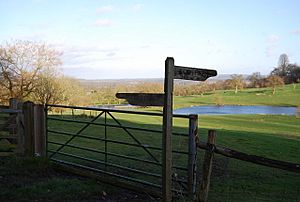Wick Wood and Worldham Hangers facts for kids
| Site of Special Scientific Interest | |
 |
|
| Area of Search | Hampshire |
|---|---|
| Interest | Biological |
| Area | 91.8 hectares (227 acres) |
| Notification | 1988 |
| Location map | Magic Map |
Wick Wood and Worldham Hangers is a special natural area located west of Bordon in Hampshire, England. It covers about 91.8 hectares, which is roughly 226 acres – that's like 226 football fields! This site is officially known as a Site of Special Scientific Interest (SSSI) because of its important wildlife and plants. It's also part of a larger protected area called the East Hampshire Hangers Special Area of Conservation.
This amazing place features very old, natural woodlands that grow on steep hillsides. These hills are made of different types of rock and soil, like the Upper Greensand and the gently sloping Gault Clay. Where these two layers meet, you can find several natural springs, which are like small streams bubbling up from the ground. While the plants on the very steep, unstable slopes might be sparse, the lower areas are full of diverse plant life, especially wild garlic. There are also two ponds here, adding even more variety to the habitats for different creatures.
Contents
What is Wick Wood and Worldham Hangers?
Wick Wood and Worldham Hangers is a protected natural space. It was officially recognized in 1988 for its biological importance. This means it's a place where many different kinds of plants and animals live. Protecting areas like this helps to keep our natural world healthy. It ensures that rare species and important habitats can continue to thrive.
Why is this Area Special?
Wick Wood and Worldham Hangers is special for a few reasons. First, it's a Site of Special Scientific Interest (SSSI). This is a special title given to the best wildlife and geological sites in the UK. Being an SSSI means the area has unique features that need to be protected. These features could be rare plants, animals, or interesting rock formations.
Second, it's part of the East Hampshire Hangers Special Area of Conservation (SAC). An SAC is an even bigger protection. It's part of a network of important natural sites across Europe. These areas are chosen because they protect specific habitats or species that are rare or threatened. This double protection helps keep Wick Wood and Worldham Hangers safe for future generations.
Exploring the Woodlands and Water
The woodlands at Wick Wood and Worldham Hangers are very old. They are called "semi-natural" because they have developed mostly on their own over hundreds of years. People might have managed them a little, but they haven't been planted from scratch. These ancient woods are home to many different plants and animals. They provide shelter, food, and breeding grounds for various species.
Ancient Trees and Unique Plants
The trees in these woods grow on steep slopes. The ground beneath them is made of different layers of rock and soil. In some parts, the soil might be thin, making it harder for many plants to grow. However, in other areas, especially lower down, the plant life is very rich. One of the most common plants you'll find here is wild garlic. When it blooms, it covers the forest floor with its green leaves and white flowers. It also gives off a strong, garlicky smell!
The Importance of Water
Water plays a big role in this area. There are several natural springs where water bubbles up from underground. These springs create small, wet areas that are perfect for certain plants and insects. The site also has two ponds. Ponds are like small lakes and they add to the variety of habitats. They are home to frogs, newts, dragonflies, and many other creatures that need water to survive. The mix of woodlands, springs, and ponds makes Wick Wood and Worldham Hangers a very diverse place for wildlife.
The Geology Beneath Our Feet
The landscape of Wick Wood and Worldham Hangers is shaped by its geology. The area sits on two main types of rock and soil layers, called "strata." One is the Upper Greensand, which forms the steeper slopes. This type of rock is often sandy and can be quite porous. The other is the Gault Clay, which is a softer, more gently sloping clay layer.
The point where these two layers meet is important. It's often where the natural springs appear. Water seeps through the sandy Upper Greensand until it hits the less permeable Gault Clay. Then, it's forced to the surface, creating the springs. This unique geology helps create the different soil conditions. These conditions then support the wide variety of plants and habitats found in the wood.

